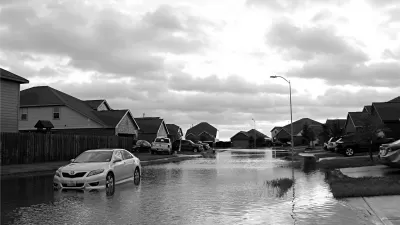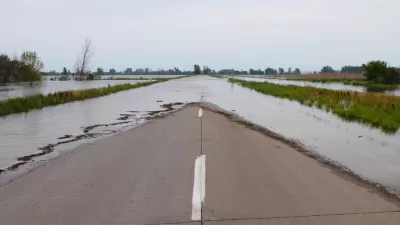Despite official calls following the 1993 floods along the Mississippi to remove development from flood plains, more housing and retail developments continue to be built along vulnerable areas.
"Once it was a cornfield; now it's a Wal-Mart, a Taco Bell, a Target. Here along a stretch of Missouri's Highway 40, in the Chesterfield Valley area just west of downtown St. Louis, what's said to be the largest strip mall in the country sits on about 46 acres of Mississippi River bottomlands. Less than 20 years ago, the land was open space.
It's been fifteen years since the Great Flood of 1993 put this land under 10 feet of water. Since then, thousands of acres of floodplain in the St. Louis area have been built up with strip malls, office and industrial parks, and 28,000 new homes. And all this infrastructure depends on miles and miles of levees to hold back the Mississippi and Missouri rivers the next time they try to retake the land.
If you ignore the historical tendency of the Mississippi and Missouri to periodically drown it, this vast, flat landscape does present an appealing canvas for building.
The Flood of 1993 was one of the most destructive in the recorded history of the Mississippi Basin: nearly 50 people were killed, over 70,000 evacuated, and 50,000 homes damaged on over 17 million acres (close to 27,000 square miles) across nine states. Over 16,000 square miles of working cropland was flooded, at a loss of more than $5 billion. All told, the flood caused around $16 billion in damage.
But official resolve to depopulate the floodplain has given way to development fever in Missouri: over $2.2 billion worth so far on land that was underwater in 1993. And unlike some of the other states deluged in the Flood of 1993, such as Wisconsin, Iowa, and Illinois, Missouri has been much slower to enact stronger regulations for floodplain development -- perhaps because the state has hundreds of miles of floodplain fronting the Mississippi and Missouri rivers (read: lots of tax income lost and jobs unrealized if new businesses and homes don't get built)."
FULL STORY: Tempting Fate: Why We Insist on Living in Floodplains

Alabama: Trump Terminates Settlements for Black Communities Harmed By Raw Sewage
Trump deemed the landmark civil rights agreement “illegal DEI and environmental justice policy.”

Planetizen Federal Action Tracker
A weekly monitor of how Trump’s orders and actions are impacting planners and planning in America.

Why Should We Subsidize Public Transportation?
Many public transit agencies face financial stress due to rising costs, declining fare revenue, and declining subsidies. Transit advocates must provide a strong business case for increasing public transit funding.

Understanding Road Diets
An explainer from Momentum highlights the advantages of reducing vehicle lanes in favor of more bike, transit, and pedestrian infrastructure.

New California Law Regulates Warehouse Pollution
A new law tightens building and emissions regulations for large distribution warehouses to mitigate air pollution and traffic in surrounding communities.

Phoenix Announces Opening Date for Light Rail Extension
The South Central extension will connect South Phoenix to downtown and other major hubs starting on June 7.
Urban Design for Planners 1: Software Tools
This six-course series explores essential urban design concepts using open source software and equips planners with the tools they need to participate fully in the urban design process.
Planning for Universal Design
Learn the tools for implementing Universal Design in planning regulations.
Caltrans
Smith Gee Studio
Institute for Housing and Urban Development Studies (IHS)
City of Grandview
Harvard GSD Executive Education
Toledo-Lucas County Plan Commissions
Salt Lake City
NYU Wagner Graduate School of Public Service





























